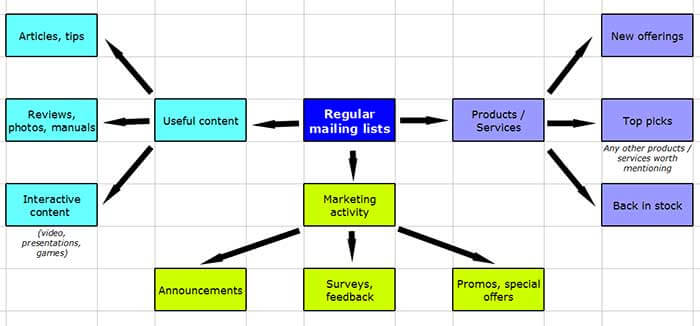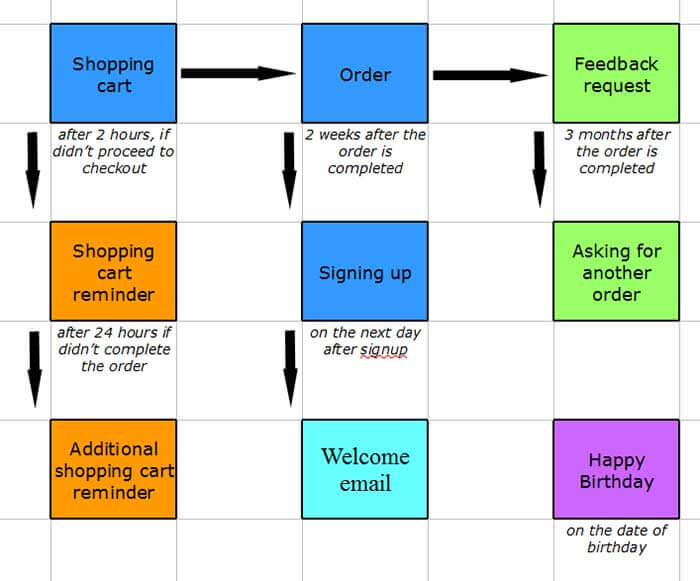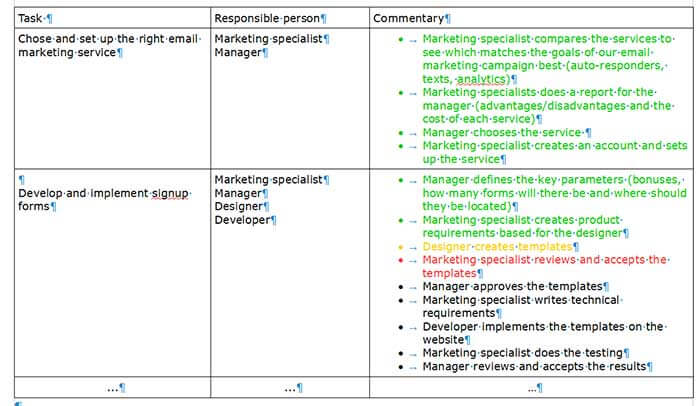So much has been said about email marketing campaign before in various sources, that it seems like there’s nothing else to write about.
Still, every day when you open your inbox, you can clearly see that not all people have learned their lesson well. It’s ridiculous, how many marketers (both young and seasoned) tend to ignore the basic rules and principles of successful email marketing campaign.
If you don’t want to become one of them, read on to find out:
- how to approach email marketing the right way;
- how to create and launch successful email marketing campaign.
Email Marketing Is a Part of the Bigger Picture
Emails are essentially just a marketing channel, through which you reach out to your potential customers (much like your website, social networks or contextual advertising). So there isn’t such thing as “standalone” email marketing – you should always envision it as a part of your overall marketing strategy.
Therefore, you should employ all available marketing tools for that strategy and plan your email marketing activities as a part of such.
For example, there’s a mall somewhere with tons of visitors during weekends, but on the weekdays there isn’t a single soul in it. In order to improve the situation and attract some more visitors on the weekdays, the management decided to launch special promo activities. Where there’s a company, there’s a website. Where there’s a website, there are people who left their email once while signing up. So the company uses this channel (via email marketing) to increase the potential visitors’ awareness of the ongoing promotion. Email marketing is just a complementary tool here, used to enhance the overall marketing strategy in order to – guess what? – earn more money!
Email Marketing Plan Structure
Email marketing is much easier to comprehend when it’s divided into a few steps, typical for any kind of business (e-shop, services company or a media website). These steps are:
1. Goal setting → 2. Competitor analysis → 3. Collecting emails and building your mailing list → 4. Segmentation → 5. Sending emails to subscribers on a regular basis →6. Automated mailing lists → 7. Metrics
Let’s describe each step in detail.
1. Goal Setting
As we mentioned before, the goals of email marketing campaign correspond with those of overall Internet marketing strategy. They can include:
- increasing the amount of recurring orders;
- increasing ARPU (Average Revenue Per User);
- decreasing the number of support tickets.
In order to be able to control the situation, you should consider setting realistic and measurable goals. Don’t go after more than 3 or 4 goals at once.
Email marketing plan: setting goals
Of course, every goal can have several objectives, which can be measured by themselves. But for now we’ll just concentrate on the key metrics, which can clearly indicate if there’s something terribly wrong (or right).
For this step we’ll just list the goals, e.g. for an e-shop:
- drive more traffic;
- get more orders;
- increase revenue.
For a B2B company the goals may be as follows:
- drive more traffic;
- generate more leads;
- increase conversion rate;
- decrease customer churn rate.
Then we set the realistic metrics for each goal, based on the previous experience or approximate calculations: 5,000 site visitors, 50 orders, $1,500 in revenue and so on. These are the key metrics for us to look at when we analyze the results every month.
2. Competitor Analysis
Let’s make a table and put the competitors’ names in columns, while each row of that table will contain a certain important parameter, such as:
- the amount of available subscription methods;
- the availability of regular/automated mailing lists;
- usage of notifications.

You can also add such parameters as design, types of emails, segmentation, tools used for managing mailing lists etc.
If there’s something you want to take a note of, you can put it in a separate “Notes” column.
In order to fill in the table, you should create a few “spare” inboxes and join the mailing lists of your competitors. You may want to go the full way of a typical visitor/customer – from registration to the confirmed order – to see what happens on each step.
After a few weeks of observations (usually from 2 to 4 weeks, depending on your competitors’ activity), you can summarize everything you’ve learned and put it under the table, e.g.:
- competitor 1 has the fastest growing mailing list;
- all competitors run promotional emails only, on a regular basis;
- no one really has automated mailing lists;
- notifications are text-only;
- in general, the level of email-marketing in the given market is “satisfactory” at best
- I should take competitor N as a prime example.
If the level of your competitors is quite low, you should just outperform them by doing the obvious things. However, if the competition is strong, you should try to think outside of the box and find your own way to get ahead of everyone.
3. Collecting Emails and Building Your Mailing List
Here are some of the popular practices you can utilize to collect emails:
- pop-up window;
- signup form on the side/in footer;
- signup page;
- collecting emails offline;
- other forms (registration, lead generation etc.).
You don’t have to write a full description for each practice – a short commentary would do:
- pop-up window: signup bonus ($10 off coupon);
- signup form (down below in footer + separate form on the main page);
- signup page (add to “Company” section).
The specifics can be done on the stage of implementation, e.g. while writing project requirements for designer, programmer etc.
4. Segmentation
It’s not obligatory, but may be quite useful. Here you should define the segments you’re about to focus on, based on the:
- demographics (age, gender, income rate);
- interests (based on survey data);
- behavior (by collecting user activity data on the website and mailing list).
If you know your segments already, you can easily collect the necessary data, e.g. add the relevant fields to the signup form, create additional parameters in the database etc.
One thing you should consider is that the segments have to be large enough to generate revenue, while limited in quantity – not more than 10. Ideally – under 5. This is mainly because managing a segment involves a lot of work – if you’re not up for it, you’d better not do segments at all.
Instead, you can focus on personalizing your emails via dynamic content and auto-reply forms (we’ll get to that soon).
Here’s what a typical segment may look like in your plan:
- “Golden clients” (more than 3 orders, over $1,500) – no additional stimulation required. Consider showing respect by sending bonus content 3 times per year and a “thank you” letter once a year.
- “Silver clients” …
- “Bronze clients” …
What we’ve got so far
So far we’ve laid a nice foundation for your email marketing campaign by:
- setting the goals, which fit the overall marketing strategy;
- defining the methods of growing our subscriber base;
- segmentation (optional).
Yet, the most interesting part is still ahead – we have to set up the regular and automated mailing lists, which we’re going to manage. Not to mention the metrics system for each email marketing campaign and monthly reports.
So far we’ve covered four steps out of seven, which are:
1. Goal setting → 2. Competitor analysis → 3. Collecting emails and building your mailing list → 4. Segmentation → 5. Sending emails to subscribers on a regular basis →6. Automated mailing lists → 7. Metrics
Now let’s move on to the second and final part.
5. Sending Emails on a Regular Basis
This basically means sending out emails to all subscribers or segments in “manual” mode, based on certain schedule. Here, it’s all about regularity and systemic efforts – that’s how you succeed. And in order to succeed, you should:
– create a detailed list of content
Decide what you’re going to send to your subscribers and not just in general terms (news, promo, special offer):

You can add comments to the each type of content, for example:
Articles. Publish articles on the following subjects (subject 1, 2 and 3) in the blog monthly. Announce these articles via the email – a couple of paragraphs + “read more” button.
– be periodical
Define how often you are going to send emails. For example, once a week for general mailing lists and once a month for each segment.
It would also be nice to draw a schedule for at least a month ahead: just a simple calendar to see if different mailing lists don’t get in each other’s way and everything goes smoothly.

– set up the processes
You should formally describe the main stages of an email marketing campaign: text → images → design → sending → tracking results. Define who will be responsible for each of these stages, the tools they should use and the timescale they should adhere to. Don’t go into much detail here, a common description would be enough, e.g.:
Get everything ready for sending through Mailchimp in accordance with the requirements. Create a task at least three days beforehand. Define who is responsible for what:
- copywriter creates a text based on the requirements;
- designer supplies images/illustrations;
- front-end developer creates a template;
- marketing specialist uploads the template to the email marketing service and sends out the actual email. He also tracks and analyzes the results after 7 days.
6. Automated Mailing Lists
Besides email blasts on a regular basis, you might want to consider creating automated mailing lists to make your email marketing campaign a bit more personalized. A typical automated mailing list includes:
- welcome-email (or even a series of such, if you have enough content);
- “unfinished action” notification (e.g. incomplete purchase in an e-shop);
- “give us your feedback” email;
- “N days have passed since you did something” email;
- “Happy Birthday” email.
You can also draw a nice little diagram with notes for each email you plan to send:

Here’s an example of such note:
- Welcome email. Let people know how often you’re going to send these emails, the sections, show where to unsubscribe, ask to add you to their contact list.
- “Happy Birthday” email. Congratulate on the birthday and give 300 bonuses.
Don’t forget about the “service” notifications that may come from your website. You should create a full list of such notifications, draw a diagram and mention redesign (if there is such need) – this will definitely add a few points to your email marketing campaign.
As a result of the aforementioned activities, you should get a roadmap for your email marketing campaign. Apart from the information about the regular and automated mailing lists, you can also include the places where you collect emails (signup forms, landing pages), completed actions, enabled services etc.
7. Tracking Results
This is quite important, because whatever we do, we want to be sure we’re doing it right and be able to measure it.
You don’t really have to create these huge tables full of numbers, but there are some things which are more or less required: setting up goals in Google Analytics, getting promo code counter, signup sources etc.
You can create a list of metrics, which are of the most importance to you and track them on a monthly basis:
- new/unsubscribed users;
- average click/open rates;
- average web analytics data (orders, bills, revenue);
- overall traffic;
- overall amount of orders and revenue generated by email marketing.
Compare the results with the goals you set back in paragraph 1 and make adjustments if necessary.
Step-by-Step Guide to Creating and Launching Email Marketing Campaign
Since email marketing plan involves some practical actions, it would be wise to complement it with a step-by-step guide, which will describe your actions on each stage of implementation.

To add a little interactivity, you can mark different stages with colors, depending on the status (e.g. green – done, yellow – awaiting confirmation, red – in progress). This will make the document much more informative and practical.
Final Thoughts
The easier your plan, the better. Complicated plans are harder to implement – they take up much resources and mental efforts.
That’s why you should consider making small steps first: create a few signup forms, launch a regular mailing list, a welcome email, maybe do some split-tests. As you keep growing, you can add more fancy stuff like triggers, segmentation, and detailed analytics.
Still, you’ve got to know when to stop. If a system is too complicated, it will inevitably fail. You’ll know when this moment comes – it usually happens after you create a dozen segments, sophisticated data tables and endless automated mailing lists.
Once you’ve reached that point, try improving the results via content marketing, experimenting with the ideal time to send emails, better offers, and easier metrics. In other words, step back, take a breath and try a different approach.
Probably, you would love to see an example of a “working” email marketing campaign plan. However, if posted here, this plan can be a subject of another article or two 😉
Conclusion
The suggested structure is not something that is set in stone. You can modify it to your needs, throw away the stuff, which is not relevant to you, and add something that is missing, e.g. the paragraph about how to choose the right email marketing service, how to manage subscriber base or communicate with partners.
As a result, you should probably get a 10 to 20-page document (depending on how ambitious you are), which will lay the foundation for your email marketing strategy for months ahead. In today’s ever-changing world, it’s a common thing to revise such strategies once in three months. You may consider doing a 6-month or even a yearly plan, but don’t try to look any further than that.
Who knows, maybe in a year things like push-notifications will be irrelevant due to new technologies, so don’t try to predict the future, act in accordance with the current situation.
Set realistic and down-to-earth goals, such as attracting X subscribers and earning Y dollars during the upcoming year – that should do it.
The right thing to do would be share this article with your friends on the social networks – just click on one of the icons of social media, it’s that easy.
If you have further questions on the subject, please write them in comments – I’ll be glad to answer.





Hello to every one, it’s really a good for me to pay a quick visit this web page,
it consists of valuable information.
You’re welcome Henry, glad it helped
This is the right blog for anybody who would like to understand this topic. You understand so much its almost tough to argue with you (not that I really would want to…HaHa). You definitely put a new spin on a subject that has been written about for many years.
Great stuff, just excellent!
You’re welcome Rodrigo, glad this was helpful
Hi there! I could have sworn I’ve been to this blog before but after reading through some of the post I realized it’s new to me. Nonetheless, I’m definitely delighted I found it and I’ll be book-marking and checking back frequently!
Glad I could help 🙂 If you have any questions or need further assistance, please let me know!
Appreciate the recommendation. Will try it out.